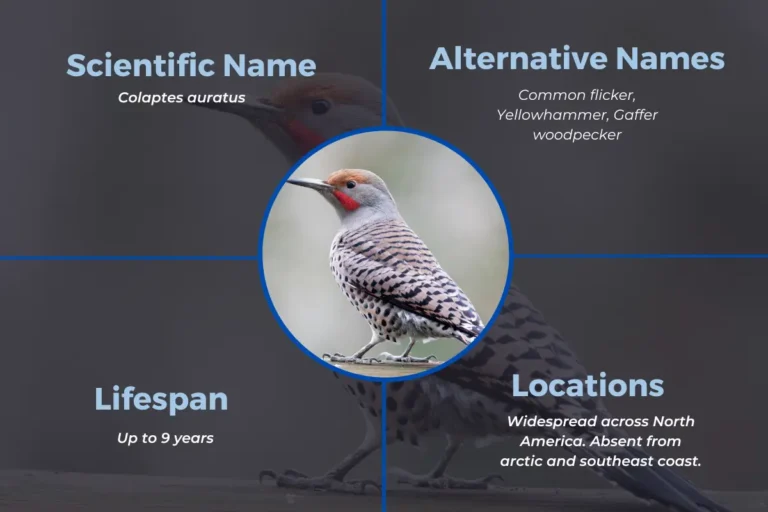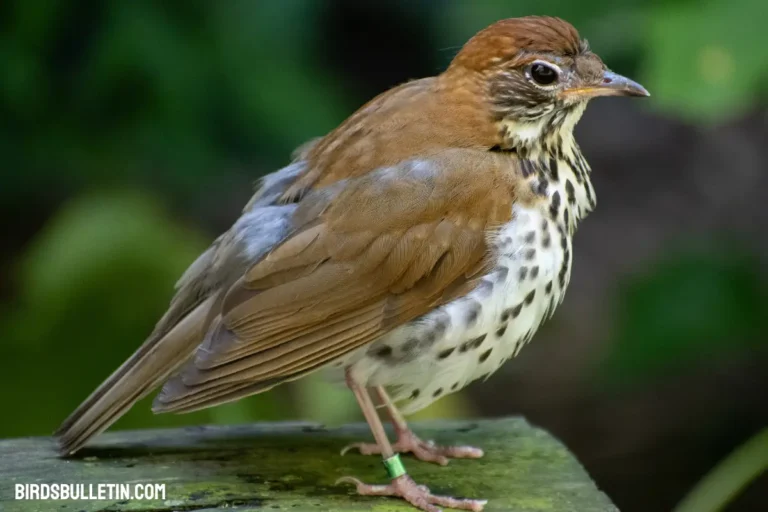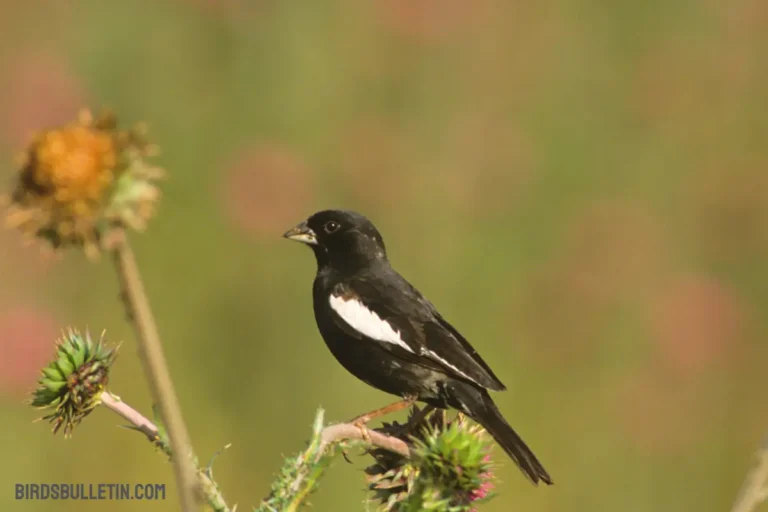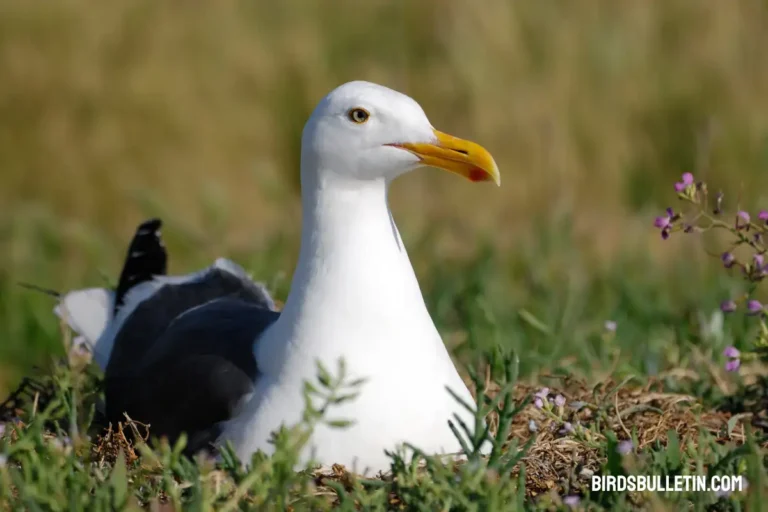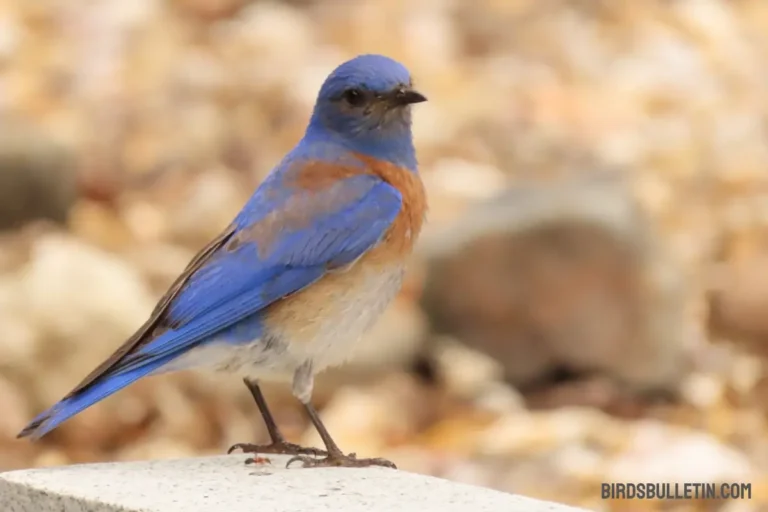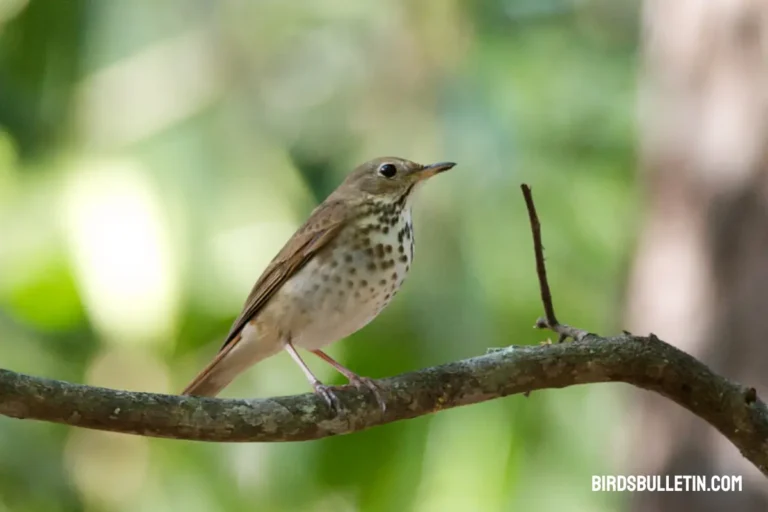Ring-Necked Pheasant: Nesting Habits, And Subspecie
With its bright plumage and hearty adaptation to farmlands, the ring-necked pheasant has become an iconic game species associated with rural landscapes.
Though not native, it continues a legacy of successful introduction on new continents as an upland hunting favorite.
Want to learn more about Birds Overview
Identification Step-by-Step
Identifying a Ring-necked Pheasant involves looking at various physical characteristics. Here’s a step-by-step guide to help you identify these birds:
01. Size and Shape:
- Ring-necked Pheasants are medium to large-sized birds, with a length of about 24-36 inches (60-90 cm) from the tip of the beak to the end of the tail.
- They have a long, pointed tail that can be as long as their body.
02. Coloration – Male (Rooster):
- The male Ring-necked Pheasant is more colorful and distinctive than the female.
- Look for a striking combination of iridescent green and purple head with a distinctive white neck ring, which is often difficult to see unless the bird is close.
- The body is adorned with various shades of brown, copper, and gold feathers.
- The long tail feathers are typically iridescent green with black barring.
03. Coloration – Female (Hen):
- Females are more cryptically colored to provide better camouflage.
- They are generally mottled brown and tan, helping them blend into their surroundings.
- The female lacks the bright colors and long tail feathers seen in males.
04. Head and Bill:
- The head of the male is adorned with colorful plumage, while the female has a more subdued head with a mottled appearance.
- The bill is relatively short and slightly curved downward.
05. Eye and Facial Features:
- Pheasants have a distinctive eye ring around their eyes.
- The facial skin may have bright colors, especially in males, and can vary from red to blue.
06. Voice:
- Male pheasants are known for their distinctive crowing calls, especially during the breeding season.
Ring-necked Pheasant Profile
| Aspect | Information |
|---|---|
| Scientific Name | Phasianus colchicus |
| Alternative Name | Common Pheasant |
| Color | Male: Colorful with iridescent green, purple, and white neck ring. Female: Mottled brown and tan. |
| Size | Approximately 3 feet |
| Wingspan | 60-90 cm |
| Weight | Male: 2-3 pounds (0.9-1.5 kg), Female: 2 pounds (0.9 kg) |
| Lifespan | Average 3 years,11 to 18 years in captive |
| Breeding Season | Mid-March to June |
| Lay Eggs | A female ring-necked pheasant lays 50-60 eggs in spring and summer |
| Diet and Prey | Omnivorous diet, feeding on seeds, insects, small invertebrates, and vegetation |
| Threats and Predators | Threats include habitat loss, predation by mammals (foxes, raccoons, etc.), and hunting. |
| Locations | Native to Asia, but introduced worldwide for hunting. Common in grasslands, agricultural areas, and open fields. |
State Bird, And Symbol
The ring-necked pheasant is designated the state game bird or state bird of South Dakota. People connect the species with countryside traditions like hunting clubs, preserves catering to catch-and-release recreation tourism, and game dinners showcasing local flavors.
It adorns signs, merchandise, baked goods, festivals from Pheasantfest to the Mr. Pheasant Pageant, and more expressions of rural heritage.
Subspecies of Ring-Necked Pheasant
Up to 30 geographic subspecies of ring-necked pheasants have been described from their native Eurasian range, varying slightly in size and color tones. In the United States, most states originally introduced the domesticated Chinese subspecies P. c. colchicus for game farms.
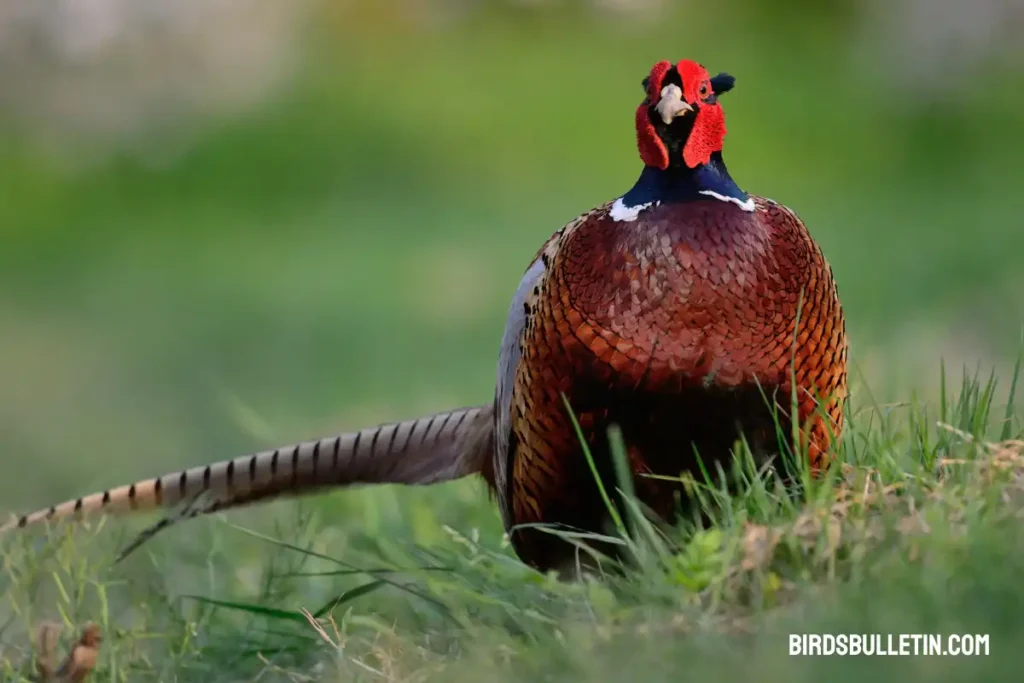
But early releases and subsequent mixing make subspecies purity uncertain. Modern game-propagated birds tend to be larger due to captive rearing improving survival rates more than revealing genetic distinctions.
Nesting Habits
Common pheasants are ground-nesting birds, and their nesting habits are influenced by various factors, including habitat, weather, and local conditions. Here are some general aspects of the nesting habits of ring-necked pheasants:
1. Nesting Site: Pheasants prefer to build their nests on the ground, usually in tall grass, weeds, or other dense vegetation. The female selects a concealed location that provides good cover and protection from predators.
2. Nest Structure: The nest itself is a simple depression in the ground, lined with grasses, leaves, and other plant materials. The female may use her body to shape the nest and create a shallow bowl for the eggs.
3. Concealment: Pheasants are known for their secretive nesting behavior. The female is highly camouflaged, and she relies on her cryptic plumage to blend into the surroundings. The nest is typically well-hidden to avoid detection by predators.
4. Egg Laying: The female lays a clutch of eggs for several days, with one egg added to the nest each day. The typical clutch size ranges from 8 to 15 eggs, although it can vary. The eggs are usually brown or olive-colored, helping them blend in with the ground.
5. Incubation: After laying the complete clutch, the female begins incubating the eggs. The incubation period lasts approximately 23 to 29 days, during which the female stays in the nest to keep the eggs warm and protected.
6. Male’s Role: The male is not directly involved in incubation but may stay in the vicinity to defend the nesting area and the brooding female. He plays a role in protecting the nest from potential threats.
7. Hatching and Chick Rearing: Once the eggs hatch, the female leads the chicks away from the nest to find food. Pheasant chicks are precocial, meaning they are born with their eyes open and are capable of moving around shortly after hatching.
8. Predator Avoidance: Pheasants face numerous threats during the nesting period, and they rely on their secretive behavior and cryptic plumage to avoid detection by predators. If a nest is disturbed or destroyed, the female may lay another clutch to replace it.
Population and Migration
Partners in Flight provides an estimate of the global breeding population for ring-necked pheasants at approximately 56 million. While captive stocks and releases bolster numbers for hunting, self-sustaining wild ring-necked pheasant densities peaked in the 1960s before intensive agriculture altered the countryside habitat.
They now range from common locally to absent in unsuitable areas or after harsh winters, avoiding dense forests and mountains. Seasonal movements shift between winter farmyard vicinity and summer nesting grounds but generally do not exceed 20 miles.
Behavior
Ring-necked pheasants exhibit various behaviors that are influenced by factors such as their environment, reproductive cycles, and interactions with other individuals. Here are some key behaviors of ring-necked pheasants:
01. Foraging: Pheasants are ground foragers, searching for seeds, insects, small invertebrates, and vegetation on the ground. They use their strong bills to peck and scratch the soil.
02. Roosting: Pheasants roost in trees or shrubs at night for protection from ground predators. However, they spend the majority of their time on the ground during the day.
03. Social Structure: Ring-necked pheasants often form loose flocks, especially outside the breeding season. Males may establish territories during the breeding season and become more solitary as they focus on attracting mates.
04. Mating Displays: Male pheasants engage in elaborate courtship displays to attract females. These displays may include puffing up their colorful plumage, erecting their neck feathers, and making distinctive calls.
05. Parental Care: Once the chicks hatch, the female leads them away from the nest, providing guidance and protection. Pheasant chicks are precocial, meaning they are born with their eyes open and are capable of independent movement shortly after hatching.
06. Avoidance of Predators: Ring-necked pheasants are known for their evasive behavior when faced with potential threats. They rely on their ability to hide in dense vegetation and use their cryptic plumage to blend into their surroundings.
07. Flight: While pheasants are primarily ground-dwellers, they are capable of short, powerful flights. This ability allows them to escape predators and move between different foraging areas.
08. Territorial Defense: During the breeding season, males may establish and defend territories to attract mates. This can involve displays, calls, and, if necessary, physical confrontations with other males.
Interhuman Connection
Beyond economic value supporting game land access and hunting tourism, ring-necked pheasants link people to countryside heritage through folk art carvings, meal traditions, and even high school team names.
South Dakota celebrates the species on license plates with the caption “Pheasant Country.” Dogs trained to flush and retrieve game birds connect hunters with wild pheasant encounters.
Conservation Status
Ring-necked pheasants number over ten million in North America thanks to millions of game farm-reared and released birds supplementing self-sustaining wild ones. The species’ global IUCN conservation ranking remains Least Concern.
But native Great Plains grassland losses exceeding 50 percent since European settlement significantly undermine wild population viability without sustained artificial bolstering through states’ hunting license funds.
Legal Protections
In the U.S. ring-necked pheasants fall under state jurisdiction for management regulations as an introduced species. Most states allow recreational hunting seasons targeting roosters, generating revenue supporting periodic restocking that maintains opportunities.
Otherwise, there are no federal special protections, though a hunting license is required to legally harvest pheasants where season dates and bag limits vary locally. Illegal taking carries fines.
Frequently Ask Questions
01. Why are ring-necked pheasants named that?
Male ring-necked pheasants show a distinctive white band circling their necks separating the iridescent green head from the coppery body, while females have a muted buff band. This ring stands out when the birds strut.
02. Where do ring-necked pheasants come from?
The ring-necked pheasant is native to Asia, originally living in open habitats from the Caspian Sea region across Kazakhstan to Manchuria and Korea. It has established feral global populations after introductions.
03. How long do ring-necked pheasants live?
In the wild, ring-necked pheasants rarely exceed three years old, with most perishing their first year. But in captivity where protected, they have lived over 10 years. Loss of winter habitat and cover to avoid predators curtails lifespans.
Final Word
Whether glimpsed dashing through roadside grasses or seen hanging in a place of pride after the annual hunt, the ring-necked pheasant remains an icon of traditional countryside living.
Like an embroidered patch on a hunter’s jacket, may this striking imported game bird continue gracing North America’s fields!
References
- Leif, A.P. 2005. “Ring-necked Pheasant” (On-line), Animal Diversity Web. Accessed November 26, 2023 at https://animaldiversity.org/accounts/Phasianus_colchicus/
- Madison, L. A., Comfort, S. R., & Carroll, J. P. (2002). Overwinter Survival of Wild and Pen-Reared Ring-Necked Pheasant Hens. Wildlife Society Bulletin (1973-2006), 30(2), 513–519.
- Trautman, C. G. (1982). History, Ecology and Management of the Ring-Necked Pheasant in South Dakota. South Dakota Department of Game, Fish and Parks.


